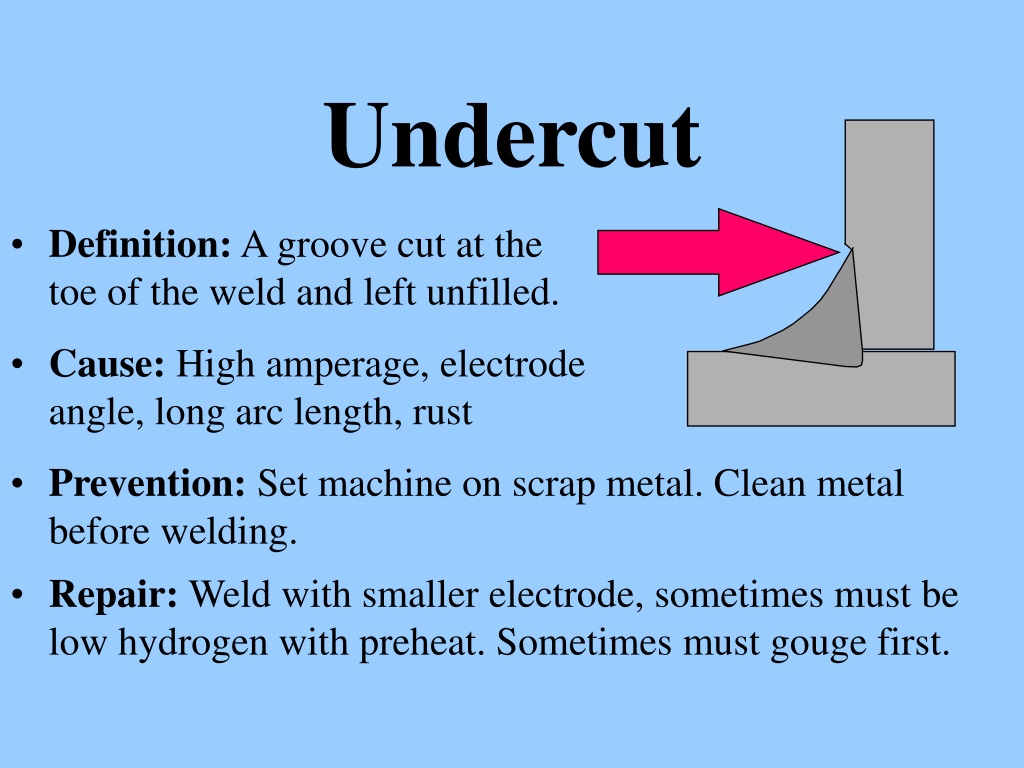Preventing Weld Undercut Made Easy: Key Techniques Unveiled
Preventing Weld Undercut Made Easy: Key Techniques Unveiled
Blog Article
Grasping the Art of Welding: Exactly How to Prevent Undercut Welding Issues for Flawless Manufacture Results
Effectiveness and accuracy are critical on the planet of welding, where even the slightest blemish can jeopardize the structural honesty of a made item. One usual obstacle that welders face is undercutting, an issue that can weaken a weld joint and lead to expensive rework. By comprehending the source of undercut welding and executing effective strategies to avoid it, welders can elevate their craft to new levels of excellence (Preventing weld undercut). In the quest of flawless construction results, grasping the art of welding to prevent undercut concerns is not just an ability but a need for those striving for excellence in their work.
Comprehending Undercut Welding

To protect against undercut welding, welders need to guarantee correct welding parameters, such as adjusting the current, voltage, traveling rate, and maintaining the proper electrode angle. Furthermore, using the appropriate welding strategy for the details joint arrangement is vital. Using weaving motions or backstepping techniques can help make sure appropriate weld steel deposition and minimize the probability of undercut development. Normal assessment of welds throughout and after the welding process is also important to catch any kind of undercut early and make necessary adjustments to stop more flaws. Preventing weld undercut. By comprehending the sources of undercut welding and executing safety nets, welders can achieve high-quality, structurally sound welds.
Reasons For Undercut in Welding
Understanding the aspects that add to undercut in welding is necessary for welders to produce top notch, structurally sound welds. Insufficient welding existing or incorrect welding speed can likewise add to damage. Understanding these causes and applying proper welding methods can assist protect against undercutting problems, making certain long lasting and solid welds.
Techniques to avoid Undercutting

To mitigate the threat of damaging in welding, welders can use calculated welding techniques aimed at enhancing the top quality and honesty of the weld joints. In addition, making use of the right welding method Read Full Article for the particular joint configuration, such as weave or stringer beads, can add to lowering damaging.
Using back-step welding techniques and managing the weld grain profile can additionally help distribute warmth uniformly and decrease the risk of this website undercut. Routine inspection of the weld joint during and after welding, as well as applying quality guarantee actions, can aid in identifying and dealing with undercutting concerns promptly.
Significance of Correct Welding Parameters
Choosing and preserving ideal welding parameters is vital for attaining effective welds with minimal problems. Welding specifications describe variables such as voltage, existing, take a trip speed, electrode angle, and shielding gas flow rate that straight influence the welding procedure. These parameters should be meticulously readjusted based upon the sort of material being welded, its thickness, and the welding technique employed.
Proper welding specifications make sure the ideal quantity of warmth is put on thaw the base steels and filler product consistently. If the criteria are established expensive, it can cause too much warmth input, creating burn-through, spatter, or distortion. On the various other hand, if the specifications are as well low, incomplete fusion, absence of infiltration, or damaging may happen.
High Quality Assurance in Welding Operations

Conclusion
To conclude, grasping the art of welding requires a comprehensive understanding of undercut welding, its reasons, and strategies to avoid it. By ensuring correct welding specifications and implementing click for source quality control practices, remarkable construction outcomes can be accomplished. It is important for welders to consistently pursue excellence in their welding procedures to prevent undercut issues and create top quality welds.
Undercut welding, an usual flaw in welding processes, happens when the weld metal does not properly load the groove and leaves a groove or anxiety along the bonded joint.To avoid undercut welding, welders need to guarantee correct welding specifications, such as readjusting the current, voltage, traveling rate, and preserving the proper electrode angle. Insufficient welding incorrect or present welding rate can also add to damage.To reduce the threat of undercutting in welding, welders can utilize critical welding techniques aimed at improving the top quality and integrity of the weld joints.In final thought, understanding the art of welding requires a complete understanding of undercut welding, its reasons, and techniques to avoid it.
Report this page